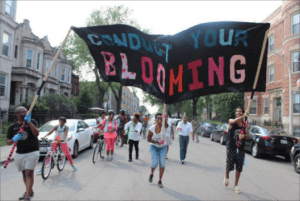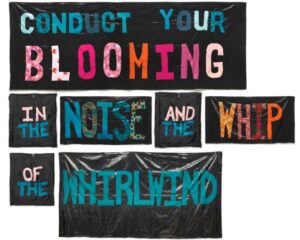Review of Cauleen Smith (October 21–December 3, 2016)
“CONDUCT YOUR BLOOMING.” Large fabric  letters in a quilter’s assortment of blues and pinks are stitched by hand onto a black, sequined banner.
letters in a quilter’s assortment of blues and pinks are stitched by hand onto a black, sequined banner.
At twelve and a half feet long and bisecting a corner of the room, Cauleen Smith’s banner takes over the “East Wing” of Corbett vs. Dempsey. The tight space also functions as a meeting room, where the reflective surface of a large black table repeats the banner’s message but does so as if in an echo chamber. And yet it is best that the gallery has not pretended to make this work at home on a wall: it is meant to be on parade.
Smith created the banner for the Black Love Procession, which she organized in September 2015 in response to an exhibition at Gallery Guichard in Bronzeville. That exhibition included an artist’s restaging of Michael Brown’s death, specifically his corpse, which remained in the street about four hours after he was shot by a police officer in Ferguson, Missouri. Smith’s featured banner is one of seven in the complete work that together proclaim a line from a Gwendolyn Brooks poem: “Conduct your blooming/ in the noise and the whip/ of the whirlwind.” The poem Smith references on the banners is part of Brooks’ In the Mecca, her 1968 collection depicting the troubled lives of residents in the historic Mecca apartment building in Bronzeville.
As coordinator of the Black Love Procession, Smith took Brooks’ words into action as the “conductor” of a spontaneous band of artists and friends to promote a different vision of what takes place on the pavement in Black neighborhoods.
To celebrate love and hope as an antidote to ignorance and violence, participants—community gardeners of a sort—marched from the Chicago Defender newspaper offices to Gallery Guichard.
In photographs documenting the procession, the standard-bearers appear to be wearing gardening gloves in eye-catching colors: pink, green, blue, purple and yellow. This gesture towards a uniform signals both the power of spectacle and purposefulness of community labor. Processional performance is not new for Smith. Inspired by her research on Sun Ra’s Arkestra,
Smith has organized at least five iterations of the “Solar Flare Arkestral Marching Band,” as “onsite flashmobs” at various Chicago locations, from Chinatown to the Museum of Contemporary Art. Parades are loud, celebratory displays of coordinated publics. For Smith, these qualities make this form useful as one of resistance.
“The thing is resistance. Resistance is the Thing,” writes Smith in her manifesto included in Human_3.0 Reading List 2015-2016. This publication accompanies the exhibition and it is what saves the gallery from rendering Smith’s work a dormant relic. If the banner rests with the energy of potential future processions, Smith’s publication contains the seeds of engaged conversation and evolution. Her reading list comes in the form of 57 drawings of books that she says will provide readers with a partial “vaccine” for the plague of violent policing and oppression that besieges Black people in America. “While standing in the street, talk about what you are studying. While renovating your greystone, plant something that will live longer than you.”

Conduct your Blooming exhorts viewers to grow, using verbs that suggest this action is both measured and organic. One might interpret the statement as an artistic maxim, directing the artist to create beauty by cultivating natural expression. The tone of the phrase is preemptory: Take control! A statement out of time, it is an invitation to begin an already ongoing process.
Cauleen Smith’s work exists as a record of action to urge future action. Smith writes, “This reading list is for the Doers-Who-Think; not the academics who think there’s no point.” A banner can only come alive when it is raised and in motion. In the open air, the blue and pink letters evoke an evening skyscape floating atop the razzle-dazzle black sequins that catch the sunlight. Just as Smith’s manifesto prescribes study as action, Conduct your Blooming offers the opportunity to reconvene our intentions and energy for another march.
Smith’s 57 works on paper from the Human_3.0 Reading List will be exhibited in Spring 2017 at the Art Institute of Chicago.
Kate Hadley Toftness
Kate Hadley Toftness is an arts writer based in Chicago. As an organizer of things and culture, she focuses on archival practices that promote new creative work and social justice. In 2017, she is curating a year-long project convening artists to activate underutilized archives across the city.
Volume 31 number 3 January / February 2017 pp 33-34
